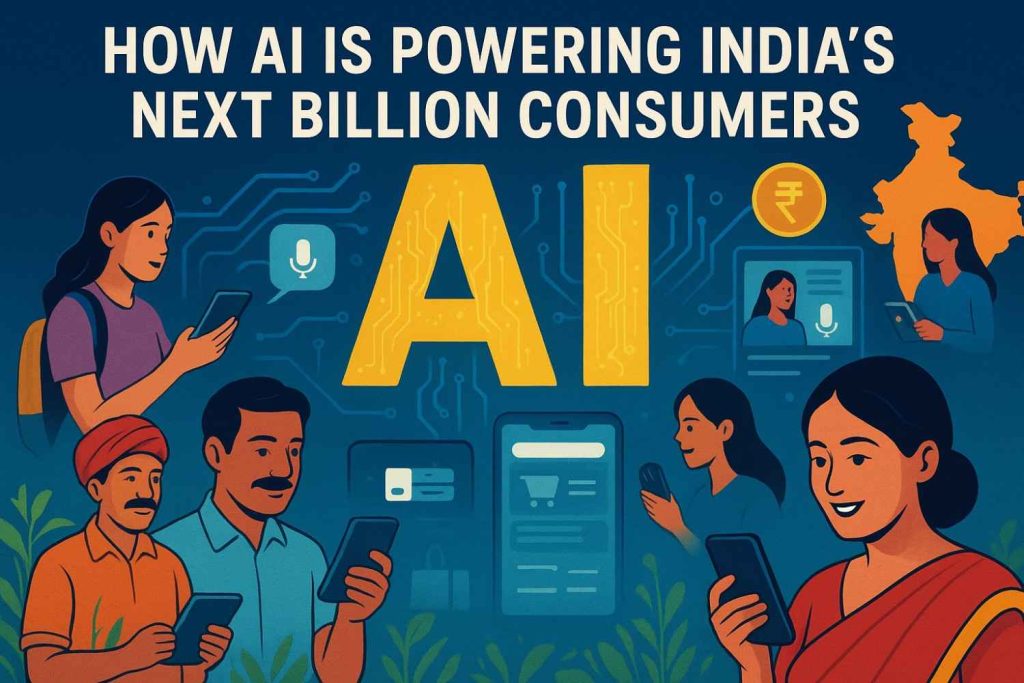How AI is Driving India’s Next Billion Consumers
India stands on the brink of one of the greatest digital transformations in modern history. With over 1.4 billion people, of whom nearly 700 million are internet users, the next phase of economic growth will be shaped by the next billion consumers — individuals who are connecting, consuming and creating online for the first time.

What’s driving this massive change? Artificial Intelligence (AI).
From smart recommendations on e-commerce apps to regional language voice assistants and AI-driven credit scoring for rural entrepreneurs, AI is quietly but powerfully transforming how Indians shop, learn, earn and live.
As connectivity deepens and affordable smartphones become ubiquitous, India is witnessing an AI revolution at the grassroots level — a shift that’s democratizing access to opportunities and reshaping the consumer landscape.
1. The Rise of India’s Next Billion Consumers
For decades, India’s digital economy was dominated by urban, English-speaking, tech-savvy users. But that’s changing fast. Thanks to the Jio revolution, affordable smartphones and cheaper data plans, rural India is now the fastest-growing internet market in the world.
- This “Next Billion” segment consists of:
- Tier-2 and Tier-3 city residents
- Non-English speakers
- First-time digital users
- Consumers from lower and middle-income backgrounds
They are digital natives in their own right — using mobile apps for shopping, payments, entertainment, and education — often skipping the desktop era altogether.
AI has emerged as the bridge that connects these users to the digital world — helping them interact naturally through voice, image and regional language technologies.
2. AI-Powered Accessibility: Breaking the Language Barrier
India’s linguistic diversity is both its strength and challenge. With over 22 official languages and hundreds of dialects, language has historically limited access to technology and digital services.
Enter AI.
Advances in Natural Language Processing (NLP) and speech recognition have enabled technology platforms to communicate in multiple Indian languages. Google, Amazon Alexa, and Indian startups like Reverie, Karya and Bhashini are developing AI systems that understand and respond in local languages such as Hindi, Tamil, Bengali and Marathi.
For example:
- Voice search queries in India are growing at over 50% year-on-year.
- Regional language content consumption is expected to surpass English content by 2026.
- AI chatbots in vernacular languages are helping farmers access weather updates, crop advice and government schemes.
This linguistic inclusivity ensures that technology is not just for the English-speaking elite, but for every Indian, regardless of literacy level.
3. Smart Commerce: AI Redefining How India Shops
India’s e-commerce ecosystem has evolved dramatically with AI integration. Platforms like Flipkart, Amazon, Meesho, and JioMart use AI to personalize experiences for millions of users.
AI influences consumer behavior in several ways:
- Personalized recommendations: Algorithms suggest products based on browsing patterns and past purchases.
- Dynamic pricing:AI adjusts prices based on demand, supply and consumer intent.
- Visual search: Users can upload a photo of an outfit or product and instantly find similar items online.
- Voice shopping:Consumers in rural areas can now simply say “Saree dikhaiye” or “Sabun kharidna hai” and AI-powered apps understand and respond.
Even small merchants are benefiting. Platforms like Shopify, Dukaan, and Instamojo integrate AI tools that help sellers analyze trends, automate marketing and manage inventory.
This convergence of AI and commerce is not only improving efficiency but also expanding market access for local businesses — empowering India’s small retailers to compete in the digital era.
4. AI in Financial Inclusion: Bringing Banking to the Underserved
One of the most profound impacts of AI in India has been in financial inclusion. For decades, millions of Indians lacked access to formal banking due to limited documentation or credit history.
AI is changing that narrative through:
- Credit scoring models based on alternative data like mobile usage, transaction patterns and e-commerce behavior.
- Chatbots and voice botsguiding rural customers through loan applications in regional languages.
- Fraud detection systems ensuring secure digital transactions.
Fintech leaders like Paytm, PhonePe, KreditBee, and Slice use AI to assess creditworthiness for first-time borrowers, while RBI’s UPI ecosystem has made digital payments seamless across every corner of India.
AI is turning India into a cashless, financially inclusive economy, where even a farmer in Bihar or a homemaker in Nagpur can access instant loans and manage digital wallets with ease.
5. AI in Education: Personalized Learning for Every Student
Education is another frontier where AI is reshaping India’s future. Startups such as BYJU’S, Vedantu, and Khan Academy India leverage AI to deliver personalized learning experiences.
- AI-driven systems:
- Analyze a student’s strengths and weaknesses
- Recommend custom lesson plans
- Offer adaptive quizzes and instant feedback
Moreover, AI-powered translation and voice-based learning platforms are helping students from rural and semi-urban areas learn in their native languages.
In government schools, AI-enabled attendance tracking, teacher support, and digital content delivery are improving outcomes.
The result? Education is no longer confined to classrooms or elite institutions. It’s becoming personalized, inclusive, and accessible to millions.
6. AI in Healthcare: A Lifeline for the Masses
In a country where doctor-patient ratios remain low, AI is acting as a force multiplier.
- Telemedicine platforms powered by AI triage tools help diagnose common ailments remotely.
- AI diagnostic systems detect diseases like tuberculosis, diabetes and cancer at early stages.
- Predictive analyticsforecast disease outbreaks and help optimize resource allocation.
Startups such as Qure.ai, Niramai, and HealthifyMe are revolutionizing healthcare accessibility. For rural India, where hospitals are scarce, AI-driven mobile health units and chatbots are becoming the first point of medical contact.
The integration of AI with public health initiatives could very well be the key to universal healthcare in India.
7. AI for Bharat: Empowering Rural Innovation
Beyond urban tech corridors, India’s villages are also experiencing an AI awakening.
- AIis being applied in agriculture, logistics and governance:
- Precision farming: AI models predict crop yield, monitor soil health and optimize irrigation.
- Agri-tech startupslike DeHaat, CropIn and Gramophone use AI to connect farmers with buyers and suppliers.
- Smart logistics optimize supply chains for rural delivery networks.
- AI in governance:Platforms like DigiYatra, e-Kranti and AI-based grievance redressal systems are improving citizen services.
This AI for Bharat movement ensures that technology serves as an equalizer — narrowing the rural-urban divide and fueling sustainable development.
8. Challenges Ahead: Ethics, Privacy and Digital Literacy
Despite its promise, India’s AI revolution faces challenges.
- Data privacyconcerns are rising as more users share personal information online.
- Algorithmic biascan perpetuate social inequalities if not carefully managed.
- Digital literacygaps remain a barrier in fully realizing AI’s potential.
Government policies such as the Digital Personal Data Protection Act (DPDP 2023) and initiatives under IndiaAI Mission aim to create a responsible and inclusive AI ecosystem.
Collaboration between policymakers, tech companies, and educators is crucial to ensure AI empowers rather than exploits India’s next billion consumers.
9. The Road Ahead: From Consumers to Creators
The story of India’s AI revolution isn’t just about consumption — it’s about creation. As India produces more AI engineers, startups, and innovators, the nation is poised to become a global AI powerhouse.
By 2030, AI could add up to $500 billion to India’s GDP, according to NASSCOM estimates. But more importantly, it will redefine how millions interact with technology — making it personal, intelligent and human-centered.
The next billion consumers are not passive users. They are digital citizens, shaping India’s AI future in real time.
AI Is The New Engine of India’s Growth
AI is not just a technological revolution — it’s a societal transformation. It’s giving voice to the voiceless, opportunity to the underserved and access to those once excluded from the digital economy.
As AI continues to evolve, its true success in India will not be measured by algorithms or profits — but by how effectively it empowers every Indian to dream, learn and prosper in the digital age.
The AI revolution is here — and it’s driving India’s next billion consumers toward a smarter, more inclusive future.































